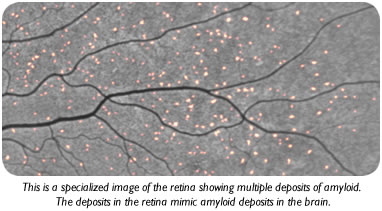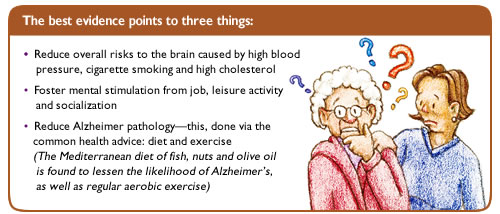|
Alzheimer’s Disease and the EyeC. Thomas Dow, MD Hands down—Alzheimer’s disease is a big problem. There are over five million Americans with Alzheimer’s and by 2050 that number is expected to balloon to sixteen million. The personal family burden is so very high and the societal weight is staggering. In 2014 the cost of providing care to those with Alzheimer’s was $214 billion—the most costly disease in the United States; the projected cost in 2050 is $1.2 trillion (in today’s dollars). That amount leaves precious little resource to research and treat heart disease, diabetes, cancer, etc. One of the greatest challenges in Alzheimer’s disease is in its diagnosis. Most often, early dementia symptoms prompt a neurologic and psychological examination. The results of the exam can provide a “likely”, but not a definitive diagnosis. Though certain brain scans and examination of spinal fluid can help diagnose Alzheimer’s disease, it is often said that the only way to have a certain diagnosis is the examination of the brain after death. That may all change with information that comes from a new method of imaging the retina, the inner lining at the back of the eye.
What can be done to prevent, postpone or otherwise affect Alzheimer’s disease? That is the trillion dollar question. We can all strive to do those things that are felt to make a difference.
Dr. Dow – Chippewa Valley Eye Clinic |



 Recent studies from Cedars-Sinai Medical Center in Los Angeles report a novel manner to detect the pathologic changes of Alzheimer’s disease well before dementia. This test involves taking a capsule at bedtime for three nights in a row; then a trip to the ophthalmologist for a dilated exam of the back of the eye, including imaging with a special camera. The capsule has a “fluorescing ligand” —a binder that seeks and attaches to certain proteins in the body. The protein sought by this binder is called amyloid—which is the abnormal aggregated protein of Alzheimer’s disease. The camera
has exciters and filters which make the protein fluoresce or “light up” in the picture of the retina. Computer-based study of the image generates a number—the “retinal amyloid index.” There was great excitement surrounding this “biomarker” for Alzheimer’s including extensive media coverage. (CNN video:
Recent studies from Cedars-Sinai Medical Center in Los Angeles report a novel manner to detect the pathologic changes of Alzheimer’s disease well before dementia. This test involves taking a capsule at bedtime for three nights in a row; then a trip to the ophthalmologist for a dilated exam of the back of the eye, including imaging with a special camera. The capsule has a “fluorescing ligand” —a binder that seeks and attaches to certain proteins in the body. The protein sought by this binder is called amyloid—which is the abnormal aggregated protein of Alzheimer’s disease. The camera
has exciters and filters which make the protein fluoresce or “light up” in the picture of the retina. Computer-based study of the image generates a number—the “retinal amyloid index.” There was great excitement surrounding this “biomarker” for Alzheimer’s including extensive media coverage. (CNN video: 